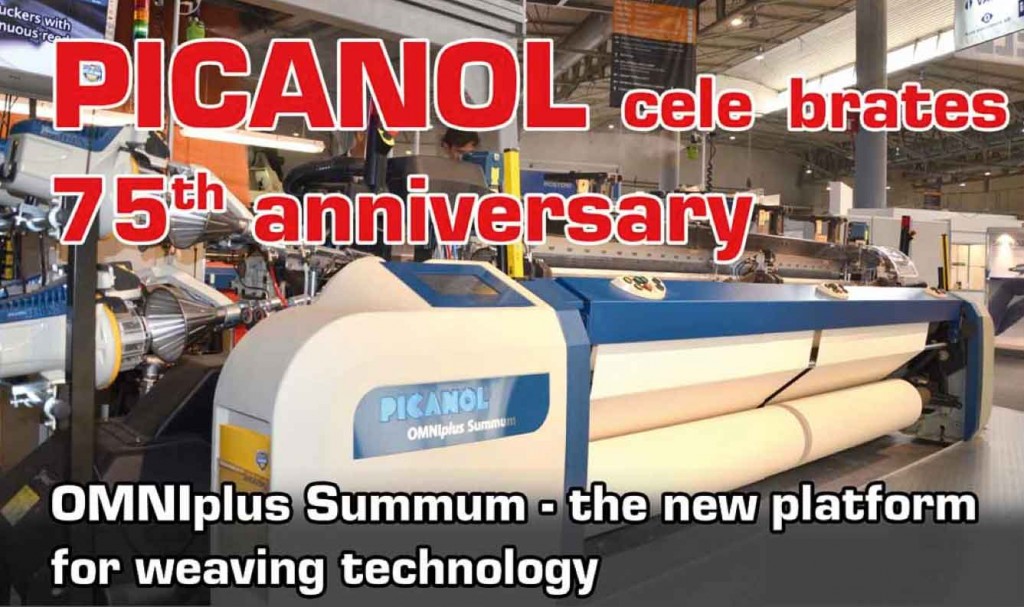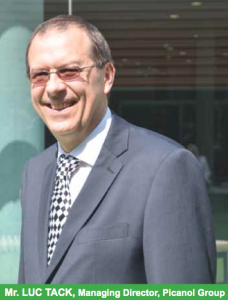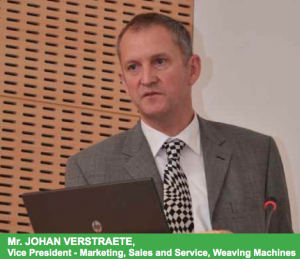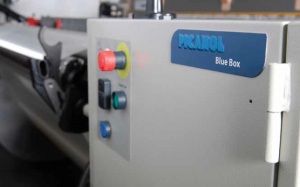
OMNIplus Summum – the new platform for weaving technology
 On September 22, the very first day of ITMA Barcelona, Picanol celebrated its 75th anniversary. The company name refers to the Spanish engineer Jaimé Picañol. His ideas shaped products that brought with them important technological advantages.
On September 22, the very first day of ITMA Barcelona, Picanol celebrated its 75th anniversary. The company name refers to the Spanish engineer Jaimé Picañol. His ideas shaped products that brought with them important technological advantages.
Since its foundation in 1936, the Picanol Group has evolved from being a very small player to the technological leader among modern weaving machine manufacturers. Picanol has launched ablog(http://75yearsofpicanolgroup.blogspot.com), which carried interesting articles about the company and its founder since inception in 1936. A commemorative edition has also been publishing the history and achievements of the company.
Mr. Luc Tack, Managing Director of the Picanol Group, said: “At ITMA we have showcased two very special innovations. The first is a new airjet that will become the new standard of weaving machinery: The Omniplus Summum. This machine combines the broadest palette of technological innovations and the high quality you can expect of Picanol”.
“On Optimax, Picanol will introduce a guided positive gripper execution. Although available in all widths, it will mainly prove useful for wider width applications in the technical segment such as coating fabrics, primary and secondary carpet backing, geogrids, etc. The development was a logical step for Picanol in order to fulfill the increasing demands from the technical segment, he added.
At ITMA Barcelona, Picanol presented its new airjet machine, the ‘OMNIplus Summum’. To be produced from 2012 onwards it will gradually replace the OMNIplus800. The main highlights of the machine are the new insertion system and the Picanol BlueBox system, the new electronic platform for the company machines.
 At ITMA Barcelona, Picanol presented its new airjet machine, the ‘OMNIplus Summum’. To be produced from 2012 onwards it will gradually replace the OMNIplus800. The main highlights of the machine are the new insertion system and the Picanol BlueBox system, the new electronic platform for the company machines.
At ITMA Barcelona, Picanol presented its new airjet machine, the ‘OMNIplus Summum’. To be produced from 2012 onwards it will gradually replace the OMNIplus800. The main highlights of the machine are the new insertion system and the Picanol BlueBox system, the new electronic platform for the company machines.
As it is the case with other Picanol products, OMNIplus Summum has been developed according to the integrated concept philosophy. This concept also is key to reach a high level of modularity.
The design of the OMNIplus Summum is based on the robust machine frame structure for which Picanol is well known. However, the two elements considered the major ones on an airjet machine – the insertion system and the electronic control – have been further improved.
The insertion system has undergone some important changes in order to be able to assure the user of the maximum possible flexibility and user-friendliness.
Picanol took the decision to introduce fully electronic pressure regulators which allow the user to set the machine electronically. Manual pressure adjustments are a thing of the past, and moreover settings can be managed!
To ensure the highest possible flexibility each weaving channel will have a separate air tank combined with an electronic pressure regulation through the machine display. As such, optimizing the machine settings to different types of yarn on the machine becomes very easy. For sure the user will be able to get the most out of his market, time and talent.
The advantages related to user-friendliness and flexibility do not mean any compromises to be made when it comes to performance and energy consumption. Already the fact that the pressure is set electronically means that this setting can only be changed by persons who are authorized to do so. Practical experience from weaving mills confirms that having full control over pressure settings is a must when it comes to keeping air consumption under control.
Furthermore, OMNIplus Summum has a unique triple air tank set-up for the relay nozzles. This development makes it possible to reduce air consumption by 10-15 per cent compared to a set-up having a double air tank. The OMNIplus Summum definitely offers the right platform for weavers to get the most out of their energy.
With the OMNIplus Summum, Picanol has introduced for the first time its new electronic platform, the Picanol BlueBox system. The system is not just a further development of the electronic system used at present on OMP800. With the new system all hard and software elements and structure have undergone a redesign. Featuring superior microprocessor performance and memory capacity, a design constructed to meet the hardest working conditions, using state-of-the-art components and detection technology, remote check-up possibility, a modular build-up and offering the user many monitoring tools, the company is convinced that this new platform will be superior to any existing system in the market, and this for many years to come.
The combination of a new insertion system and the Picanol BlueBox system creates a ‘future proof’ platform. All elements are present to allow implementation of new applications.
Positive gripper
Picanol has introduced a guided positive gripper execution of its OptiMax rapier weaving machine. The gripper is available in all widths, but will mainly be used for wider width applications in the technical segment, such as coating fabrics, primary and secondary carpet backing, geogrids, etc. The development is a logical next step for Picanol, to meet with increasing demands from weavers of technical fabrics.
The introduction of the positive gripper execution of OptiMax is the result of a carefully planned development programme, including extensive mill tests with several customers. The grippers, produced by the Picanol Group, are based on the guided gripper GC type, which has been one of the basic insertion systems on OptiMax for several years now. With the positive system, the gripper heads are now mechanically activated around transfer, and at gripping and release of the weft yarns.
This increases the capabilities of the insertion system, so that PP-tapes, bigger monofils and large multifilaments come within reach, also in wider widths and at top speeds.
The machine displayed at ITMA Barcelona not only introduces a brand new positive gripper system. It also introduces a new width for the Picanol Group, namely, 540 cm! This width fits perfectly in Picanol’s core capabilities, thanks to the company’s ongoing investments in manufacturing.
New markets
The OptiMax machine offers customers the opportunity to aim at markets previously only reserved for wide projectile machines. It will allow them to also explore markets that could not be served with projectiles due to limitations of the machine’s concept itself. Good examples of this are applications in which no oil contamination is allowed or where a large variety of wefts is needed to increase the added value of the product. OptiMax offers all of this and more without losing productivity or increasing costs.
The positive guided gripper can be replaced with negative GC grippers for those styles that do not require positive transfer but could benefit from a further boost in productivity.
As the Optimax machine was launched as recently as 2007, its technology is well suited for the coming decades. The Sumo direct drive with on-board speed control reduces maintenance work to a bare minimum, a fact that is confirmed by many leading weaving mills. The state-of-the-art electronics and stable software add to a reduced set-up time compared to other weaving machines on the market today. Flexible grippers are easier to set and to maintain over time, reducing the need for highly skilled operators during all shifts.
Picanol always strives to offer the best price-performance ratio, and this is not different for this OptiMax execution. It is an extension of the OptiMax platform which offers significant advantages in after-sales service. The machine has been plugged into Picanol’s existing customer service, including spare parts, service and training.
Picanol BlueBox
 Electronics already plays an important role in the weaving room. Its role will become even more significant in the near future.
Electronics already plays an important role in the weaving room. Its role will become even more significant in the near future.
Automation to reduce the workload of personnel and to cut energy consumption, electronic controls to meet with higher safety requirements, electronics to provide more flexibility in adapting to new situations, or for more reliability, or to enable remote support: all these are becoming increasingly important day by day.
Picanol has always been a pioneer when it comes to integrating the different machine functions and real-time applications and controlling them centrally. But with market requirements pressing for further development, the company decided to develop an entirely new electronic platform. The Picanol BlueBox is much more than an upgrade of the existing electronic platform.
Using the latest microprocessor technology, Picanol BlueBox increases calculation speeds by a factor of 10, and the larger internal memory makes it possible to store much more data, creating new opportunities for support and affording practically unlimited weaving patterns.
Picanol BlueBox is designed to fully exploit the possibilities of remote service: when it is connected to the Internet, the company specialists around the world can look right into the heart of the system. For machines that are not directly connected to the Internet, the Customer System File (CSF) can be downloaded onto a USB stick and sent to Picanol by e-mail. This file contains all the data needed by Picanol to analyze a particular situation and advise the customer on the action to be taken.
Picanol BlueBox has only a few types of printed circuit board, covering all the main functions and options in a modular way. The actual number of PCBs will depend on the features installed on the machine, but covering many functions with just a few PCBs significantly reduces the inventory of spare parts that users need to hold.
Robust and future-proof
To ensure maximum long-term reliability, Picanol BlueBox is designed to operate under the toughest conditions. To give a few examples: it can handle weaving room temperatures of up to 40°C. It is 100 per cent short-circuit protected, and inserting PCBs in the wrong position will not cause any damage.
In other words, user-friendliness and robustness are built into the system. Every component of the system, be it hardware or software, is tested to the limit before being approved for use on the weaving machine. Moreover, state-of-the-art driver technology enables the system to detect potential anomalies at a very early stage and indicate their location to the user.